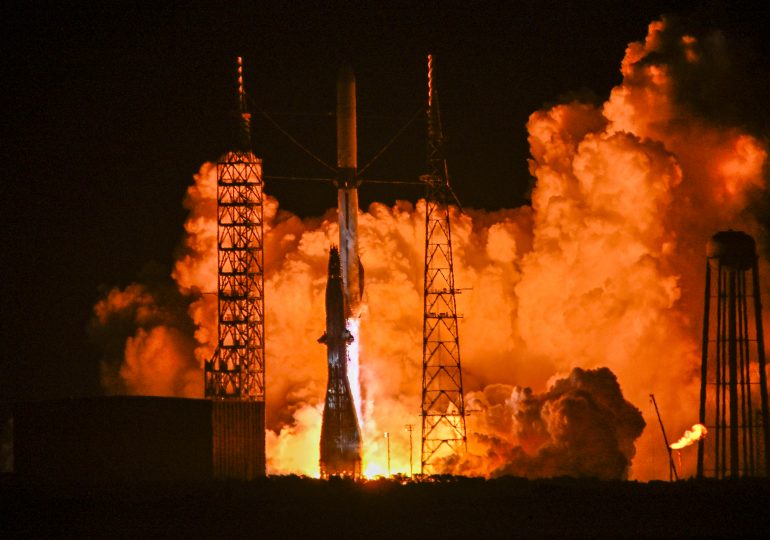A lot of hardware destined for space went to pieces this week, but to hear the rocket companies responsible for the messes tell it, little untoward happened at all. “We did it! Orbital. Great night for Team Blue,” David Limp, the CEO of Jeff Bezos’s Blue Origin posted on X, after the Jan. 14 maiden launch of the company’s New Glenn rocket ended with an upper stage payload successfully reaching orbit. The first stage, which was supposed to land gently on a downrange barge, however, crashed into the Atlantic Ocean.
[time-brightcove not-tgx=”true”]
Elon Musk’s SpaceX, meanwhile got cheeky two days later after the launch of its giant Starship rocket on Jan. 16 flipped that script. The rocket’s first stage was successfully recovered between a giant pair of chopstick-like tongs on the Texas launch pad but the second stage was lost in a massive explosion eight minutes and 27 seconds into flight. “Starship experienced a rapid unscheduled disassembly,” the company euphemistically posted on X.
It was the second part of both those X posts, however, that told the real story of the imperfect flights. “On to spring and trying again on the landing,” Limp wrote of Blue Origin’s plans for a second launch in just a few months. “Teams will continue to review data from today’s flight test to better understand root cause,” SpaceX wrote. “With a test like this, success comes from what we learn, and today’s flight will help us improve Starship’s reliability.”
Rocket science has always been an exceedingly iterative process, one in which a whole lot of launches have to come to ruin before the engineers get things right. During NASA’s early days, nearly half of the Atlas boosters that lofted the Mercury astronauts into space failed their test flights before they were finally rated safe to carry men. The Titan missiles that launched the two-man Gemini crews practically shook themselves to pieces in their first uncrewed flights. And as for the celebrated Saturn 5, the magnificent machine that launched the Apollo astronauts to the moon?
“This was a disaster,” Chris Kraft, NASA’s director of flight crew operations, told the press in 1968 after the final uncrewed flight of the Saturn 5 almost ended in a crash landing in the ocean. “I want to emphasize that. It was a disaster.”
But the Atlases flew and the Titans flew and the Saturns flew, and if space history is any guide, the New Glenns and the Starships will fly too—but not without a lot of work.
Of the two new rockets that had their try-outs this week, it was the New Glenn that had the most to prove. Blue Origin, founded in 2000, is the brainchild of Amazon CEO Bezos who envisions the company as a regular provider of space transport for both cargo and crew and a major player in making humanity both an on-world and off-world species, with millions of people eventually living in space. While the company has successfully launched 28 of its small New Shepard rockets on pop-gun suborbital missions—nine with passengers on board—it had never before placed any payload in orbit. That’s compared to a staggering 423 successful launches of SpaceX’s workhorse Falcon 9 rocket and 11 of its bigger Falcon Heavy. Starship, still very much experimental, has flown seven times.
New Glenn, which has been in development for a decade and was expected to have its first launch in 2020, has had nowhere near the breakneck R&D of the Falcons. But by many measures it has been worth the wait. The first stage is powered by seven methane-burning BE-4 engines—a cleaner fuel than the kerosene used in the Falcon 9. Together the engines put out 3.85 million pounds of thrust—about half of what the Saturn 5 produced, and just under the 5 million pounds of the Falcon Heavy. But New Glenn still counts as a muscle-bound missile.
“A single BE-4 turbopump can fit in the backseat of a car,” wrote Limp on X. “[But] when all seven pump fuel and oxygen from the BE-4’s common shaft, they produce enough horsepower to propel two Nimitz-class aircraft carriers at full tilt.”
This week’s failure to stick the first stage landing notwithstanding, the New Glenn is designed for reusability—with each rocket built for up to 25 flights—and is intended to carry both cargo and crew. With SpaceX already dominating the commercial launch field, Blue Origin would seem something of an afterthought—but it’s not. If the long drought between crewed launches from U.S. soil after NASA’s shuttles stood down in 2011 and before the first crewed Falcon 9 flew in 2020 proved anything, it’s that it is never a good idea for a country or an industry to be dependent on just a single launch system.
“Most satellite providers want to have at least two options for dissimilar redundancy,” says Scott Pace, the director of George Washington University’s Space Policy Institute.
This is truer than it’s ever been now that NASA has gotten largely out of the launch business, ceding that work to the private sector. The closest thing the space agency has today to the Saturn 5 is the Space Launch System (SLS), the massive rocket designed to be used in the Artemis program, which aims to have American astronauts back on the moon by the end of this decade. With 8.8 million pounds of thrust, the SLS is the most powerful rocket NASA has ever launched, though it still puts out just over half as much muscle as the 16 million pounds produced by the Starship. Still, SLS is a boutique machine: It has flown just once, uncrewed, in 2022, costs over $2 billion per launch, and is not set to fly again until the crewed, circumlunar mission of Artemis II in April, 2026.
“SLS operates in a hardware-poor environment,” says Pace. “You’ve only got one or two of these things. The great advantage that SpaceX has and hopefully New Glenn will have is that they operate in a hardware-rich environment. They have lots and lots of [rockets] to work with.”
Starship is proving that already. SpaceX could afford its flippancy on X because the company has always operated with a fly-fast, fail-fast, fly-again metabolism. The seven Starship launches since 2023 easily beat the poky pace of the SLS, and NASA has enough faith in the rocket that it tapped the upper stage of the Starship to serve as the Human Landing System—the 21st century version of the Apollo era lunar module—for the Artemis III lunar landing mission. Much of the work the Falcon 9 does today involves carrying cargo and crew to the International Space Station. After the station is deorbited in 2030, however, the rationale for the Falcon 9 might go with it, especially if Starship is in the flight rotation by then.
“There’ve been rumors that at the end of the space station program SpaceX doesn’t really intend to keep flying Falcon 9s,” says Pace. “So a high flight-rate Starship environment is what the New Glenn will be looking at.”
That environment, with both Starship and New Glenn flying regularly both to Earth orbit and, eventually, to the moon and beyond, will be a good one for the commercial launch sector and the U.S. in particular—especially with other countries’ boosters not viable options for American and other western customers. “We don’t use Chinese launch vehicles,” says Pace. “Russian launch vehicles are largely gone because of sanctions.” Japan’s H3 booster and the Europeans’ Ariane 6 would, meantime, welcome U.S. business but they are not now competitive with SpaceX in terms of price and likely won’t be with New Glenn either.
Even as the debris from this week’s problem-plagued launches was still hissing into the ocean, both SpaceX and Blue Origin were thus ginning up for their next flights. Space launches have always been equal parts high adventure and bruising business, and the two companies are aiming to play both bracing games.
Leave a comment








